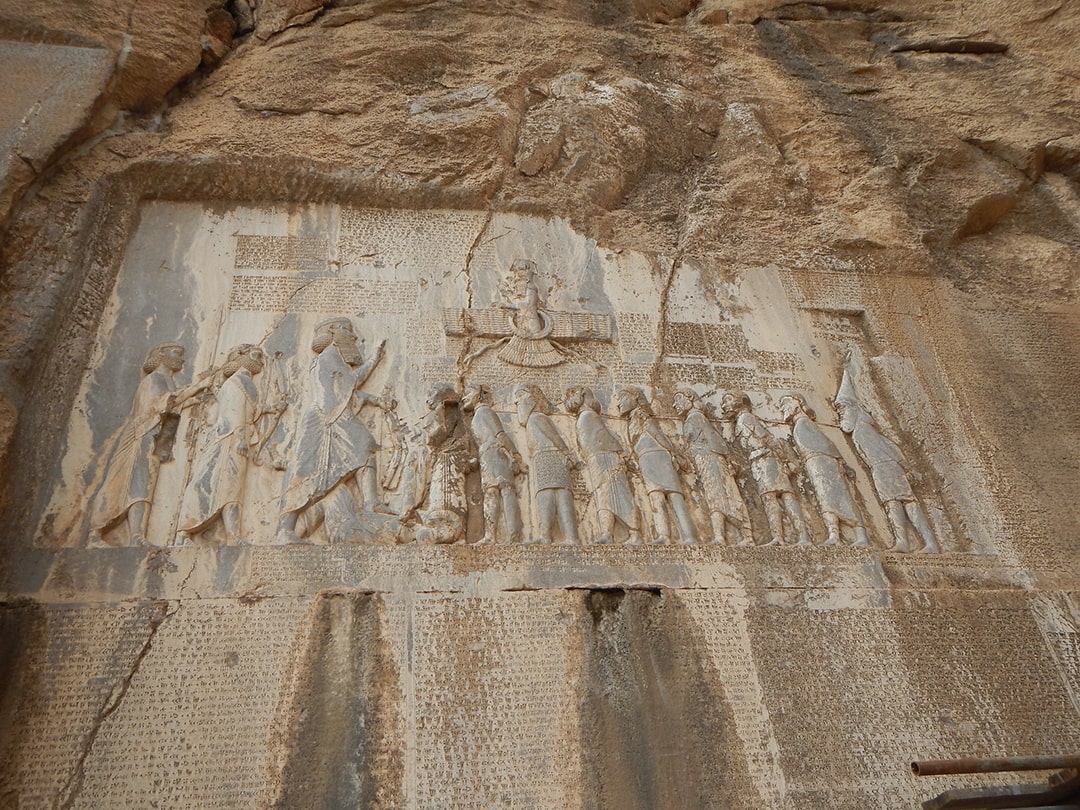Table of Contents
Bisotun, located in present-day Kermanshah, holds a special place in ancient history as a key stop along an old trading path. This path, connecting the Iranian Great Plateau to Mesopotamia, linked civilizations across different times, leaving its mark from ancient eras like the Median and Achaemenid periods to later times like the Sassanid and Ilkhanid periods.
As a World Heritage Site, Bisotun Kermanshah tells the story of ancient Iran and southwestern Asia, with an unbroken chain of history from ancient times to more recent centuries. Carved into the limestone of its hillside, the Bisotun inscription stands out as the largest and oldest known Iranian inscription, offering glimpses into the past with its mysterious characters. Traces of a brown glaze and lead layer in its earliest lines hint at ancient methods used to make it last longer, adding to its allure.
But the importance of this place goes beyond its historical relics. Positioned along the old trade route, it served both as a religious site and a bustling center of trade and cultural exchange. Its strategic location made it a hub for travelers and traders moving between western and central Iran and Mesopotamia. Recognizing its value, UNESCO designated Bisotun a World Heritage Site in 2006, ensuring its story remains for future generations to discover and appreciate.
Bisotun History
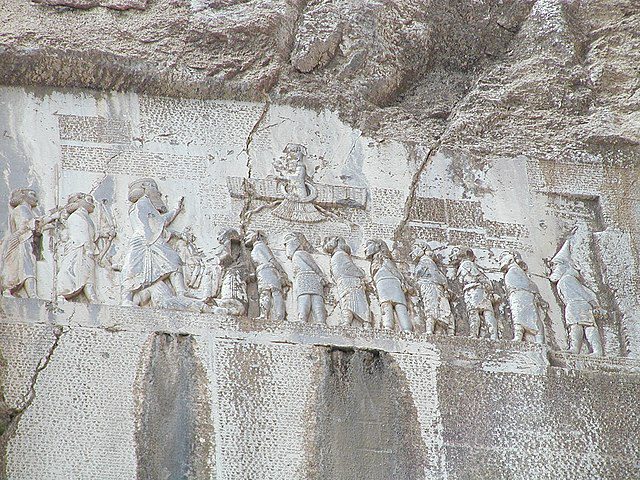
Located where old trade roads meet between Iran and Mesopotamia, Bisotun tells the story of many ancient times. From long before history was written down to the days of the big empires like the Medians, Achaemenids, Sassanians, and Ilkhanids, this place holds secrets etched in stone. The main attraction is a big carving and some writing made by Darius I, also known as The Great, back in 521 BC when he became king of Persia. In the carving, Darius is shown holding a bow, showing he’s the boss, and stepping on a person lying down, said to be Gaumata, a Mede who tried to take Darius’s place.
The writings on the rock, about 1,200 lines long, tell how Darius fought hard against governors who wanted to break apart what Cyrus had built. It’s written in three languages: Elamite, Babylonian, and Old Persian. This mix of languages not only tells us about Darius’s victories but also shows how different cultures came together in art and writing in the Persian Empire. As you walk through this place, you’ll find bits and pieces from different times, like stuff from the Medes, Achaemenids, and others, reminding us of the people who lived here long ago.
Bisotun Inscription
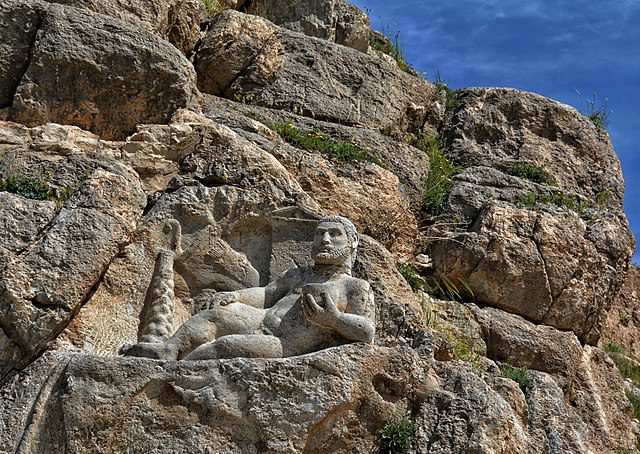
Carved high on tall cliffs in Iran, the Bisotun Inscription is a powerful reminder of ancient history. Ordered by Darius the Great, it tells a story of bravery and victory using three different ancient languages: Old Persian, Elamite, and Babylonian. This incredible work of art captures the triumph of Darius over his enemies, depicted in detailed carvings and inscriptions.
The Bisotun Inscription stands tall, 100 meters above the ground, showcasing Darius’s rise to power and his defeat of a rebellious usurper named Gaumata. In stunning detail, the carved images show Darius standing victorious, symbolizing the strength and resilience of ancient Iran.
Exploring Bisotun Iran offers a journey back in time. While the inscriptions may be hard to see due to scaffolding, a little effort reveals their hidden beauty. Amidst the rugged landscape are caves, monuments, and ancient carvings that tell stories of Iran’s past. As we unravel these mysteries, we uncover the enduring legacy of ancient civilizations, where tales of bravery and triumph continue to inspire us today.
Bisotun Etymology
The name “Bisotun” likely originated from blending “bagh,” meaning “God,” with “Estan,” which adds a sense of place, forming “Baghestan,” or “the place of the gods.” Across time, the term underwent changes, evolving from “Bahistan” to “Bahistoon” in Pahlavi, then “Bahsetun” in early Islamic times, before settling on “Bisotun” today. Interestingly, in Persian, “Bisotun” translates to “with no pillar,” reflecting its journey through different dialects. However, the exact origins remain uncertain, wrapped in the complexities of language shifts and historical interpretation.
The name “Bisotun” reveals a fascinating story of linguistic evolution. From its beginnings linked to the divine with “Baghestan” to its modern form, each step reflects changes in culture and language over centuries. Despite uncertainty about its exact roots, “Bisotun” serves as a reminder of how language evolves, shaped by history and cultural influences.
Recommended Sightseeing Time of Bisotun
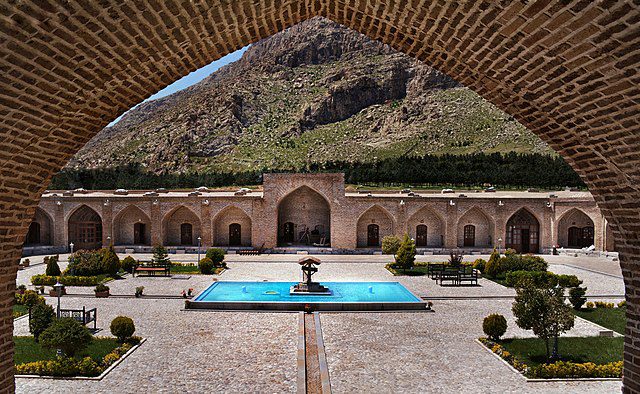
For the best experience at Bisotun Kermanshah, Iran, it’s smart to plan your visit during spring (March to May) or fall (September to November). These seasons offer pleasant weather with mild temperatures and less rain, making it easier to enjoy exploring the site and its surroundings.
Working Hours of Bisotun
In Bisotun, the typical working hours are from 8 a.m. to 6 p.m. every day, except for specific public holidays.
How to Get to Bisotun
By Plane
Flying to Bisotun is easy-peasy! Start by catching a plane from Tehran’s Mehrabad airport to Kermanshah’s Shahid Ashrafi Esfahani Airport. Once you land in Kermanshah, it’s just a quick 30-kilometer drive eastward to reach your destination. Enjoy the aerial view along the way and get ready to explore Bisotun’s fascinating history and stunning scenery!
By Car
If you’re up for a road trip, driving to Bisotun is a fantastic option. Begin your journey at Mehrabad airport in Tehran, then rent a car and head to Kermanshah’s Shahid Ashrafi Esfahani Airport. From there, it’s a scenic drive of about 30 kilometers to the east. Take your time, soak in the beautiful views, and get ready for an unforgettable adventure at Bisotun!
Where to Eat Near Bisotun
Shab Haye Bisotun
Right by the captivating Bisotun complex stands Shab Haye Bisotun, a restaurant waiting to welcome you after your tour. It’s a place where you can enjoy tasty Iranian cuisine after exploring ancient inscriptions and rock reliefs.
At Shab Haye Bisotun, you’ll find a mix of traditional Iranian hospitality and modern cooking. From juicy kebabs to fragrant rice dishes, there’s something to satisfy every appetite. Whether you’re looking for a leisurely meal or a quick snack, Shab Haye Bisotun offers a tasty break that matches the wonder of its historic surroundings.
Imam Hussein Restaurant
After exploring Bisotun, head over to Imam Hussein Restaurant for a taste of local delights. This restaurant offers hearty Persian meals in a welcoming atmosphere, perfect for refueling after your adventures.
Imam Hussein Restaurant serves up a variety of dishes bursting with flavor. From savory stews to fresh bread, there’s something for everyone to enjoy. Whether you’re in the mood for kebabs or soups, this restaurant ensures a satisfying meal that perfectly complements your day of sightseeing. So, after soaking in the sights at Bisotun, treat yourself to a delicious dining experience at Imam Hussein Restaurant.
Where to Stay Near Bisotun
Kermanshah Parian Hotel
If you’re looking for a bit of luxury near Bisotun, the Kermanshah Parian Hotel is the place to be. Set against stunning views, this hotel offers modern comforts with a touch of tradition. Friendly staff make sure you have everything you need, and the rooms are spacious and stylish. After a day of exploring, unwind with spa treatments or enjoy delicious meals at the hotel’s restaurants.
Laleh Bistoon Hotel
For a peaceful getaway close to Bisotun, consider staying at the Laleh Bistoon Hotel. Surrounded by nature, this hotel lets you escape the hustle and bustle of everyday life. With its cozy atmosphere and beautiful surroundings, it’s the perfect place to recharge. Treat yourself to local dishes and take leisurely walks in the lush gardens for a truly relaxing experience.
Other Attractions Near Bisotun
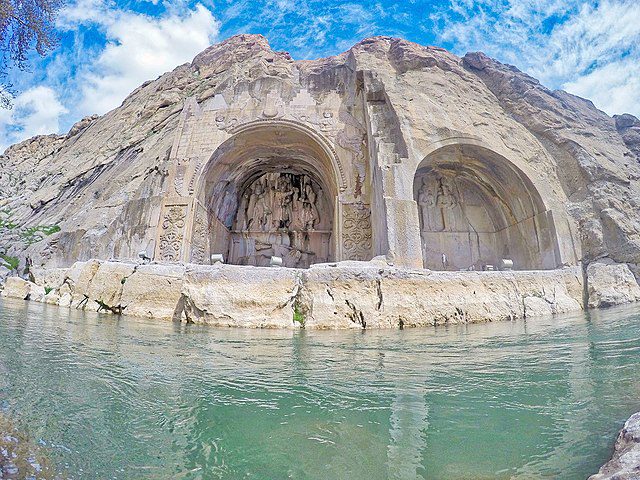
Taq-e Bostan
Beyond Bisotun lies Taq-e Bostan, a place filled with ancient wonders. Here, you’ll find stunning rock carvings and Persian-style buildings that tell stories of the past. These carvings show scenes of kings and hunting, giving us a fascinating look into the history of the area.
Quri Qala Cave
For those who love adventures, Quri Qala Cave is a must-visit. Inside, you’ll discover a magical world of rock formations that nature has crafted over thousands of years.
Ghar Parau
Ghar Parau is perfect for those seeking excitement. It’s a famous spot for cave exploration, where you can navigate through twisting tunnels and marvel at the secrets hidden underground.
Tekyeh Biglarbeygi
To experience Persian culture firsthand, head to Tekyeh Biglarbeygi. Here, you can enjoy traditional performances and admire the beautiful architecture that reflects the region’s rich heritage.
FAQs about Bisotun
Q1: What is the oldest inscription in Iran?
A1: The Behistun Inscription, also known as Bisotun, Bisitun, or Bisutun, is a big stone carving and writing made by ancient kings of Persia. It’s on a cliff at Mount Behistun in Iran’s Kermanshah Province.
Q2: Who created the Behistun Rock?
A2: The Bisitun (or Behistun) inscription is a huge carved writing on a rock in the Zagros mountains, close to present-day Kermanshah in Iran. Darius I, who was the king of the Achaemenid Empire, ordered it to be written around 520 BCE.
Q3: What is the Persian inscription on the mountain?
A3: The writing at Bisotun, which means “place of gods,” is around 15 meters tall and 25 meters wide. King Darius I commanded it to be made in 521 BC. A big part of it talks about his wins against many people who tried to take over the Persian Empire’s throne.
Q4: Who deciphered the Behistun Inscription?
A4: Henry Rawlinson, who worked for the East India Company in Persia, was the first to access and make copies of the inscriptions between 1835 and 1847. He shared his discoveries in 1849 and almost completely figured out how to read the Old Persian cuneiform writing.
Q5: Does the Behistun Inscription still exist?
A5: The Behistun monument is carved into a huge cliff on Mount Behistun, near Kermanshah, in western Iran. It includes a sculpture and writing in three languages: Old Persian, Elamite, and Babylonian Akkadian.
Last Words: Explore the Best of Bisotun with a Customized Tour
Bisotun was an important place in the past because it was on a big road where people traded stuff. This road connected Iran to Mesopotamia, and Bisotun was a key stop along the way. It has old writing carved into the hillside, and it’s the biggest and oldest one in Iran. Bisotun Iran was also a busy place for trading and sharing cultures, and it was recognized as a special site by UNESCO in 2006.
When you’re planning your trip to Iran to discover the wonders of Bisotun, going for a customized tour can make your experience truly special. At To Iran Tour, we understand the importance of creating trips that match each traveler’s unique preferences. Together, we’ll uncover the secrets of Bisotun and beyond, creating memories you’ll cherish forever.
Trust To Iran Tour to make your Iran adventure truly unforgettable.

